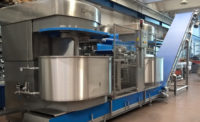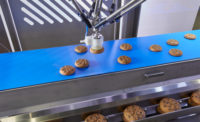Many aspects of mixing equipment for snack and bakery applications, including doughs and batters, continue to evolve, including more automated controls, better sanitary design, vacuum/pressure capabilities and shorter cycling times. The latest mixers also are designed to handle gluten-free products and help users meet requirements of the Food Safety Modernization Act (FSMA).
Market trends favoring all-natural ingredients, greater food safety and artisanal foods are increasing demand for equipment that can blend quickly and thoroughly without over-processing and potentially damaging any shear-sensitive or heat-sensitive ingredients. As a result, mixers need to have the flexibility to handle a wide range of ingredients ranging from fragile flake products to products with high fat content and those that are so fine that they behave like water when mixed and discharged.
Mixers engineered with the latest sanitary design principles in mind, such as a high degree of surface polish and construction details that promote easy cleanability, are increasingly attractive . “Utilization of shaft seals and product-discharge valves that are easy to clean have increased the quality and safety of food products,” says Ken Langhorn, technical director, Charles Ross & Son Co., Hauppauge, NY. “Most advances are related to control systems to ensure that recipes are run correctly and that batches are documented properly.”
Mixing in safety
While creating new products to meet consumer demand is a priority, so is food safety—and FSMA has made it even more so. Manufacturers are making sure that their mixers help customers comply with the new rules. Mixers with hygienic designs also help food producers increase plant efficiency and reduce production costs.
The Sanimix Batch Mixer MRMA from Bühler Inc., Plymouth, MN, features a welded assembly that eliminates potential harborage points, and is designed to facilitate access for cleaning and product changeover. Also, its full-width door enables discharge of the full mix, reducing cross-contamination.
All mixers manufactured by Admix, Londonderry, NH, can be cleaned in place between batches, which helps control allergens. “The Boston Shearmill inline mill is used to process fruit purées and fillings, ensuring an end product that is smooth and lump-free. This means that depositing nozzles stay clean and do nut plug, which guarantees an overall increase in throughput,” says George Nikolopoulos, sales manager.
“In the area of snack foods such as granola or protein bars, binders can present a challenge because it is difficult to incorporate these powdered ingredients into a relatively small amount of liquid,” says Nikolopoulos. “Here, Admix sanitary equipment mixes binders more efficiently than conventional tank mixers, ensuring no lumps or clumps downstream.”
The overall sanitary design of mixers has been upgraded in recent years. Exact Mixing, Reading Bakery Systems, Robesonia, PA, converted all of its mixers to a full-opening, clamshell design in 2010. “This was a key change and why our repeat customers always list ease-of-cleaning as a reason to remain with us,” says Jim Warren, vice president.
Bühler Inc. eliminated bolted tools from its mixer shaft and arms, moving to a fully welded design, which eliminates recesses from inside the machine. “The full-width discharge door enables the mixer to be emptied to an optimum level. The estimated residue in the mixer after discharge is 0.10 percent for dry mixes and 0.25 percent for fat mixes,” says John Hunter, sales account manager, bakery and ingredient handling.
Processing gluten-free products poses challenges, including how to increase energy input without increasing temperature. “The main challenge that gluten-free products pose is an ingredient issue, because they require a substitute binder or thickener, like xanthan gum,” says Nikolopoulos. “This gum is used to trap air to make batters light and fluffy, but is difficult for many mixers to uniformly disperse. To overcome this challenge, the Admix Rotosolver disperses various concentrations of this gum in short time intervals,” Nikolopoulos explains.
Engineered innovations
Exact Mixing has unveiled the HDX Continuous Mixer for buns and bread. Key design goals are high development while maintaining a low-temperature dough. This is accomplished in a two-stage mixing process. Rates are up to 16,000 pounds per hour, with a higher rate design in progress.
The Admix Rotosolver high-shear mixer is used for making coatings for biscuits and similar applications (e.g., spices or cheese powders into oils for spraying onto products), as well as fondants and glazes used in baking. The new Rotosolver uses 30 percent less energy and has 10 percent greater pumping capacity than previous models, the company reports.
The Rapidojet from Bakery Concepts International LLC, Enola, PA, is a continuous-hydration mixing system that processes a wide range of bakery products: bread, rolls, cake, muffins, pastry dough and gluten-free products. In addition, grain soaking, gluten and potato flake hydration have been performed with this technology.
A Rapidojet machine can process a wide range of dry ingredients and handle a hydration range of less than 50 percent to well above 1,000 percent, according to Ken Schwenger, president. “For example, Rapidojet can produce both biga hydrated at 65 percent and pre-gel starch at 1,500 percent. The key is that, instead of using a metal tool to force dry and liquid ingredients together, the system uses free-falling dry ingredients that are hit by high-pressure liquids.”
This instantly hydrates while developing gluten structure. Liquid and dry ingredients are more-homogeneously bound together. “As a result, gluten washout through the heat exchanger is reduced. This means slower starch retrogradation, the primary cause of staling. Longer shelf life is attained naturally,” Schwenger explains.
WP Bakery Group USA, Shelton, CT, reports that its new Kronos spiral mixer is a more-affordable version of its President spiral mixer. Kronos handles wheat dough, mixed wheat dough, mixed rye dough and rye dough, and can process small batches. It comes with wheel-out bowls with rubberized rollers and accommodates existing President and Titan mixer bowls.
Other features of the Kronos include a three-zone mixing principle, modular design for easy cleaning and maintenance, and USB interface for recipe management. It can easily be adjusted to meet customers’ needs through a variety of options, either as a standalone mixer or as part of a mixing system.
The Ross X-Series from Charles Ross & Son Co. is a clean-in-place ultra-high-shear mixer designed for inline emulsification, particle-size reduction and homogenization. It features a precisely machined rotor/stator that runs at top speeds of more than 11,000 fpm and forces product through concentric rows of intermeshing teeth. The combination of high fluid velocity and close tolerances between interlocking channels in the rotor/stator subjects product to intense mechanical and hydraulic shear in a single pass.
The MX-1-SS miniature rotary batch mixer from Munson Machinery Co. Inc., Utica, NY, can blend up to 1 cubic foot (28 liters) of dry bulk ingredients, with or without liquid additions, in ratios down to 1 ppm with total uniformity in two to three minutes, regardless of disparities in bulk densities, particle sizes or flow characteristics of batch ingredients. According to the company, the machine is equally efficient down to 5 percent of rated capacity, making it suitable for accurately determining outcomes when scaled up to larger rotary batch mixers.
Featuring custom, upgradeable software, the Oakes Mixer Controller from E.T. Oakes Corp., Hauppauge, NY, monitors and manages production variables such as back pressure, production rate, final specific gravity and rotor rpm. Once the mixer is installed, the operator simply selects the desired product from the recipe menu, allowing it to assume complete control of the mixer and its interface with the production line.
The Oakes mixers are self-monitoring. Multi-level touchscreens guide the user through complete diagnostic checks as the system monitors and compensates for wear over the life of the machine.
Investing in a new mixer offers snack producers and bakers the opportunity to not only handle greater capacities but also improve competitive advantage whether through higher yield, lower production costs, shorter processing time, faster changeover or a combination of these and other metrics.
“In addition to the basic factors considered in mixing equipment selection—batch size, sanitation, shear level, cycle time, safety features, loading/discharging procedure, heating/cooling mechanism and controls,” says Langhorn, “bakery/snack producers also should consider whether the new equipment can handle multiple process lines or other recipes still under development, and if the equipment will scale up easily in future installations.”









